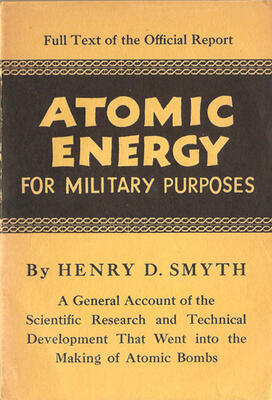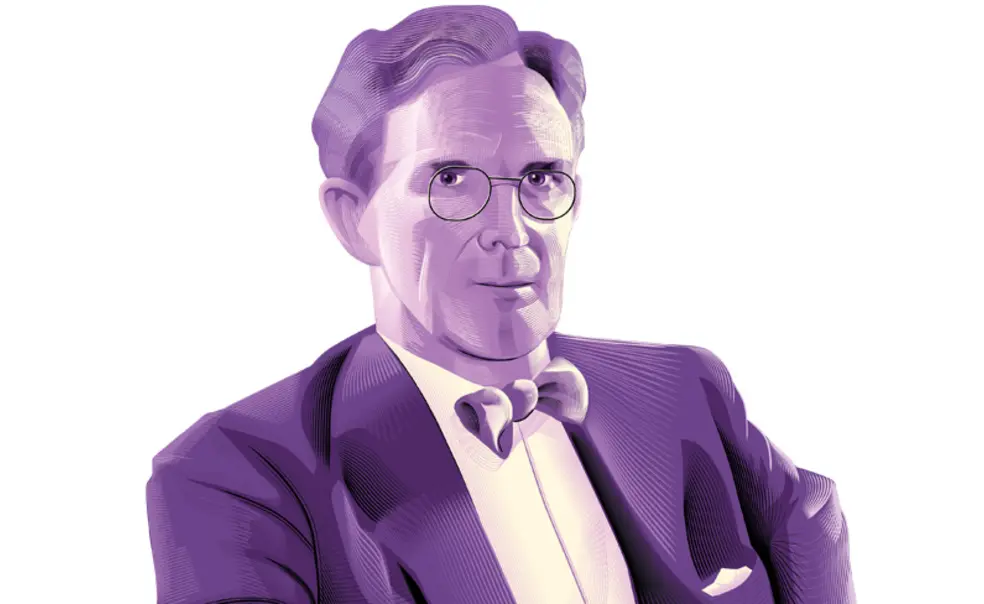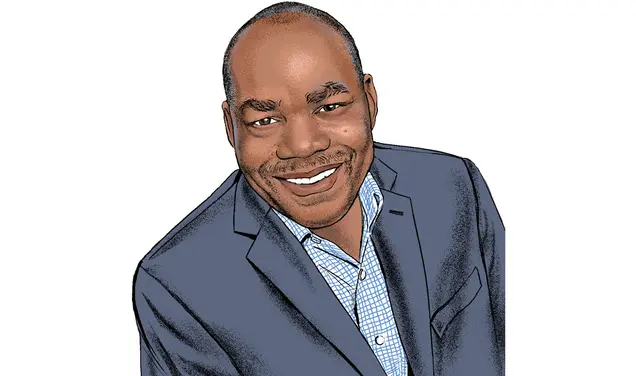How the First Historian of the A-Bomb Achieved a Misinformation Coup
Henry DeWolf Smyth *1921 penned Atomic Energy for Military Purposes for the War Department
Eighty years ago, on Sept. 15, 1945 — just weeks after atomic bombs fell on Hiroshima and Nagasaki, killing hundreds of thousands and bringing an end to World War II — Princeton University Press published a 280-page book that explained, in painstaking detail, how the bombs were made. This was the answer to exactly the question that everyone was asking, and the book, which was written by the chair of Princeton’s physics department, Henry DeWolf Smyth *1921, became an instant bestseller.
The press was able to bring out the book so astoundingly quickly for one reason, and one reason only: The book was an intelligence operation, conceived by the U.S. government during the development of the bomb to shape how the public understood the bomb — and specifically, to make it harder for other countries to build one.
It succeeded. In fact, it was a misinformation campaign so successful that we still tell its falsified story about the bomb today.
Smyth’s adventure in wartime intelligence started in early 1945, when Vannevar Bush, a top science official coordinating U.S. war research, called him into a meeting in Washington and gave him an unusual assignment. Bush knew that work in Los Alamos was progressing so well that, before the year was out, the bomb would be ready to drop — and that when it did, the world would clamor to know everything about it. Which meant the U.S. had the opportunity to release an official version of that story before anyone else, a version that would serve U.S. interests. As the historian Rebecca Schwartz *08 has shown in a brilliant study, Bush asked Smyth to write the definitive book about the weapon that would end the war, while guarding the secret that such a weapon was being developed in the first place. Smyth accepted.
Throughout that spring, Smyth spent his days writing the book in his office in Palmer Hall. While he worked, War Department guards sat in the hallway, reading detective magazines; when he left for the day, they made sure he locked his papers in a safe, then remained in his office to guard the safe. (“They did keep people from interrupting me, though,” he later told The New Yorker wistfully. “Sometimes I wish I had them back.”)
Smyth, a theoretician who wore tweed with elbow patches, was perfect for the job because he was working as a consultant for the Manhattan Project, which meant he had the requisite security classifications and understood the science. The son of a Princeton professor, he took three of his four degrees at the University, then returned there as a professor who specialized in atomic physics. After the U.S. joined the war, he became the associate director for the Met Lab until it proved impossible to keep up his work as department chair while commuting to Chicago, whereupon he switched to the role of consultant. For some of the research projects he was involved in, security protocols prohibited any communication between the groups. “I was in the position of not being legally allowed to talk to myself,” he quipped.
In June, Datus Smith 1929, the director of Princeton University Press, received a call from Smyth with a strange query. Would he rent the Press’s publishing plant to the U.S. government for two weeks? Just the plant, not the printers; the book the government wanted to print, in an edition of 5,000 copies, would have a Top Secret classification, and the printers didn’t have clearance.
“Gosh, Harry, do you really mean that?” Smith asked. “It sounds crazy to print 5,000 copies of a Top Secret item.”
Smyth replied, “Well, I suppose it might be one of those funny instances where something is Top Secret one day and in newspaper headlines the next.”
Smith, deciding the logistics were too difficult, turned Smyth down. Then, on Aug. 12, while Smith was on a beach vacation with his family, he suddenly realized the professor’s strange call must have been about the atomic bomb, which was now all over the headlines. He called Smyth from a phone booth in wet swimming trunks, got an agreement for a same-day meeting, thumbed a ride so his wife could keep their car, and was in Princeton talking to Smyth that evening.
When the Press brought out the book in September, after the world’s hastiest copy editing all-nighters, the edition they produced was 60,000 books, which sold out on the day of publication. Printing after printing, it kept selling out; it flew to the top of bestseller lists, with translations appearing in French, German, Italian, Japanese, Spanish, Russian, and other languages.
Smyth didn’t make money from the book, since it was — formally speaking — written as a government report for the War Department. Princeton University Press, on the other hand, made more than $25,000 within the year — almost half a million dollars today. The book actually cost Smyth money, since he paid $2 as a copyright fee to allow anyone to reproduce the text in full —which was desirable, of course, because the goal was to get the text shared as widely as possible.

Titled Atomic Energy for Military Purposes, Smyth’s book was brilliantly misleading for the following reason. It focused almost entirely on the work of physicists. In reality, the physics of building the bomb was relatively simple. The real challenge was to make the bomb detonate and sustain fission while doing so — which required chemistry, engineering, metallurgy, mining, and other specialties he largely left out of the narrative.
Few readers, if any, noticed that the book strategically withheld information. In fact, some accused Smyth of sharing so much information that he endangered national security. Perfect.
To this day, the story in the Smyth Report, as it was popularly called, is the story we tell about the bomb. We call World War II “the physicists’ war”; we watch films like Oppenheimer, in which a tiny clutch of wild-haired physicists seem to build the bomb simply by piecing together atoms. It’s a story that leaves out most of the people whose skills made that impossible weapon possible — from the metallurgists who refined plutonium to the women who worked as computers on the bomb’s mathematical modeling to John Johnson Gutierrez — a “factotum and jack-of-all-trades," according to mathematician Stanislaw Ulam — whose name, Los Alamos alums later recalled, was the one heard most frequently over the public address system. (Technicians know things about a research lab that the lab couldn’t run without, but which the researchers themselves never need to know.)
“I suppose Princeton can be given the dubious honor of being the birthplace of the Atomic Age,” the physicist Philip Anderson wrote in 1985. He was referring to the usual suspects — Albert Einstein, John von Neumann, Eugene Wigner, Oppenheimer himself — but also Smyth, who crafted the defining myth of the Atomic Age. That we don’t think of it as a myth — that we think of it, simply, as what happened — is a testament to the power historians themselves have over history. In the right hands, a story can be as potent a weapon as a bomb.












6 Responses
Michael Zinman
3 Months AgoPrinting History of ‘Atomic Energy for Military Purposes’
I believe the Smyth report on the atomic bomb to be the most important book printed in the 20th century. This can be debated, of course, but it will be interesting to see what others think and what they would propose.
In any event, I would like to briefly describe the printing history of the report.
Smyth prepared the report over several months before the Hiroshima bomb was dropped. Truman wanted the report for several reasons, which are not relevant to the printing history.
The first report as such was in mimeograph form, where parts were delivered, under guard, to the several senior scientists involved in its development, read by the scientist, and returned with comments if any to the guard delivering it. No copies were permitted to be kept. Two copies are extant. One (complete?) in the Smyth papers at Princeton, the other at the British Atomic Group at Harwell.
After the report was accepted by Smyth, two editions were printed. A “ditto” edition and a lithoprint edition. The ditto edition is extremely rare. I never saw a copy nor has any other dealer or collector seen one. A copy was recently found in the Smyth papers but I am not certain it is complete.
The lithoprint edition is the defining “first” edition. Arnold Kramish said it was printed in three tranches of 2,000 copies each. There was never a 1,000 copy edition. In speaking with Kramish, he said that Earle E. Coleman, who wrote checklist of editions published by The Princeton University Library Chronicle (Spring 1976), offered the 1,000 number as a guess, but it has entered the lexicon as valid.
Coleman did say that at least three copies were specially bound and given to the major players. In fact there were four, possibly five. One was given to Henry Tolman, the chief adviser to Truman, which is in my collection. The others are all in institution libraries.
Frank N. von Hippel
4 Months AgoSmyth’s Report Drew Secrecy Lines and Was Not Misinformation
In regard to Elyse Graham ’07’s “How the First Historian of the A-Bomb Achieved a Misinformation Coup” (September issue), Princeton professor Henry DeWolf Smyth *1921’s September 1945 report, Atomic Energy for Military Purposes, published by the U.S. government weeks after the bombings of Hiroshima and Nagasaki, and later republished by Princeton University Press and then Stanford University Press, was not misinformation!
As Gen. Groves, who managed the Manhattan Project for the Army, said in his preface, the report’s purpose was to publish “[a]ll pertinent scientific information which can be released to the public at this time without violating the needs of national security … . Persons disclosing or securing additional information by any means whatsoever without authorization are subject to severe penalties under the Espionage Act.”
The purpose of Smyth’s report was to make clear to those who had worked in the Manhattan Project and to journalists where the secrecy lines were drawn. Those lines were drawn based on judgments that it would be impossible to maintain secrecy about “basic scientific knowledge” or basic information about the big industrial projects that had been built around the tasks of plutonium production and uranium enrichment. The information the report contained was accurate.
Other countries interested in acquiring nuclear weapons found the report pedagogically useful but had to fill in the details themselves. In the case of the Soviet Union, the design of the Nagasaki weapon was supplied by Klaus Fuchs and Ted Hall, ideologically motivated spies who felt that it would be too dangerous for the U.S. to have a monopoly on nuclear weapons. The Soviet nuclear weapon designers, in fear of being executed if their first test failed, tested the Nagasaki design before testing their own designs (see Michael D. Gordin’s 2009 book, Red Cloud at Dawn).
Editor’s note: The author is a professor of public and international affairs and senior research physicist emeritus in Princeton’s Program on Science and Global Security.
Mark Goodman *86
4 Months AgoAt Penn, Exploring Sensitive Topics in Fission
There's an interesting follow-up to the Smyth Report. My father, Bernard Goodman, was then a graduate student and the youngest member of a group of physicists from the University of Pennsylvania who were curious to understand the physics details behind the Smyth Report. The group, led by assistant professor William Stephens, had been part of the wartime efforts to develop radar and sonar, but not the bomb. They held a series of seminars and compiled their notes into a book length manuscript titled Nuclear Fission and Atomic Energy. They submitted it for publication in 1946, but security concerns delayed its publication until 1948. While they were not censored, the authors were persuaded to drop the discussion of implosion, which was at the time considered one of the most sensitive secrets of the Manhattan Project. You can find the full published version online and an article about it in the May 2012 issue of Physics Today.
Charlie Bell ’76
4 Months AgoSimilar Challenge, Three Decades Later
In his celebrated how-to-build-an-atomic-bomb paper written as an undergraduate in 1976, John Aristotle Phillips ’78 likewise concluded that the ultimate bomb making challenge wasn’t theoretical but practical: What was the ideal shape and composition of the cluster of explosives needed to trigger the bomb? According to the “A-Bomb Kid” himself, he found the answer to the latter question by simply picking up the phone, calling the head of a division at DuPont, and asking!
It wasn’t so easy at Los Alamos.
Jim Antal ’72
4 Months AgoReading Smyth’s Book
I’ve had a copy since I was 10 or 11 years old. Any others out there?
Peter Calderon ’65
4 Months AgoCompelling Story, With or Without the Missing Pieces
It’s the story that counts. The audience of 60,000 who bought the book upon its publication didn’t care about the science that was left out of the compelling storyline. And the third parties who were very interested in the missing science knew that it was missing and would eventually obtain it in the traditional way: espionage and their own devices.